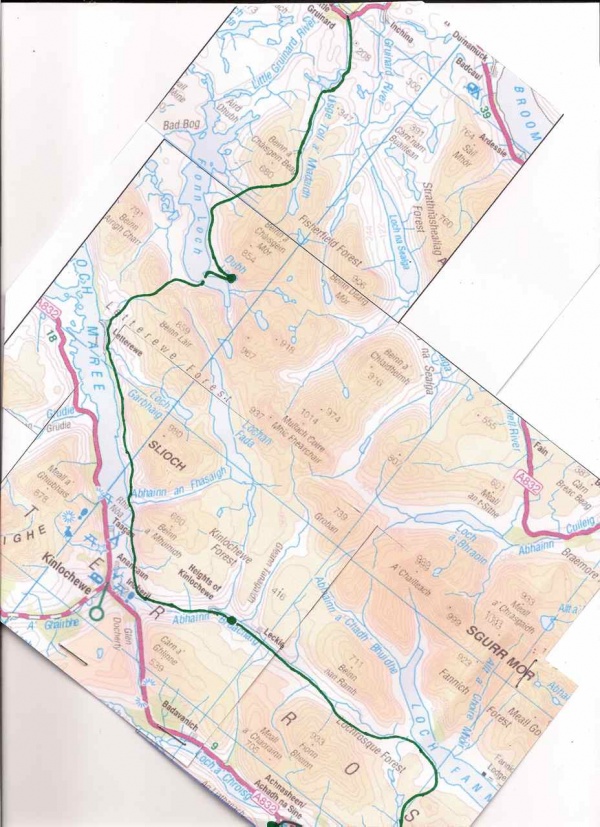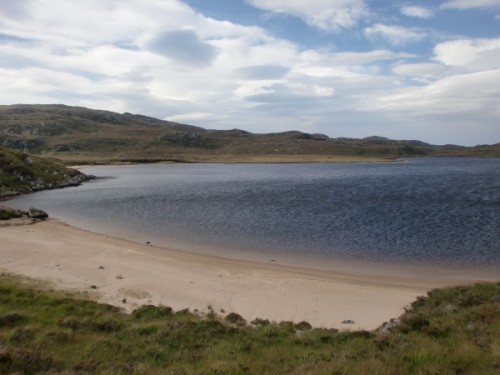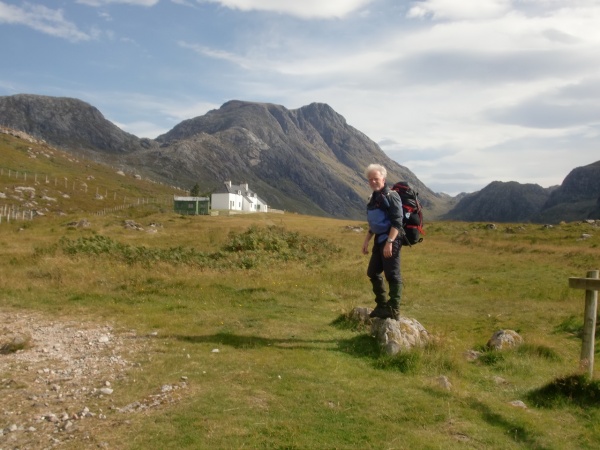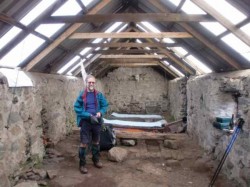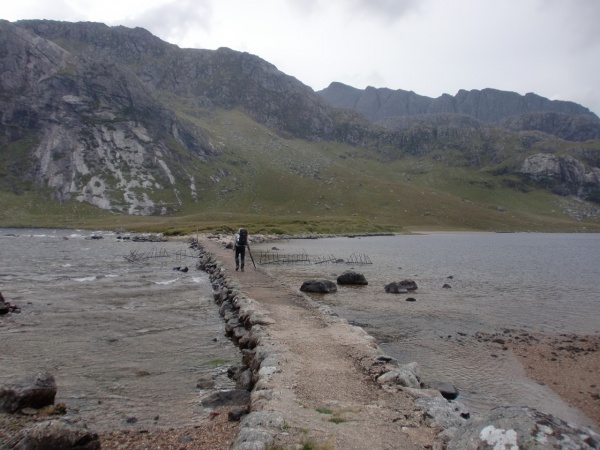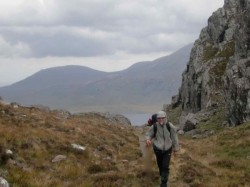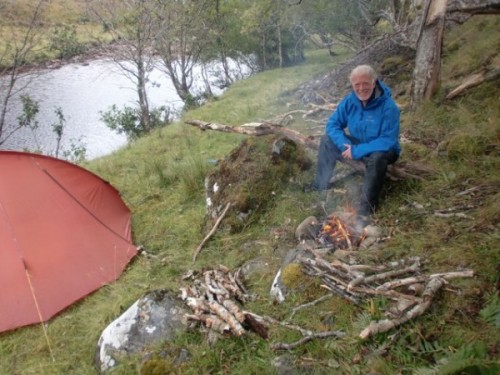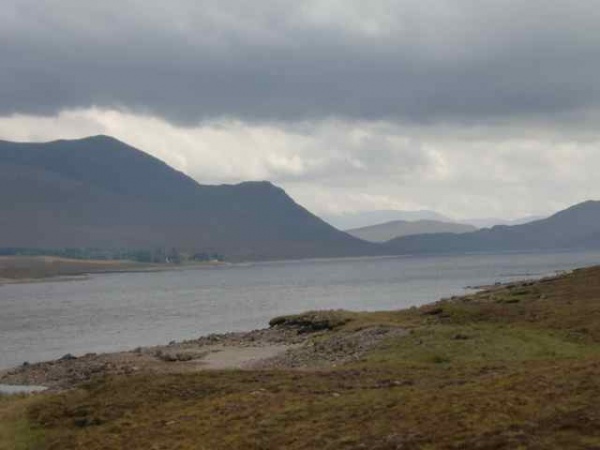THE FISHER KINGS
5th to 7th September 2010
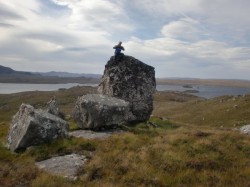 It was blowing a full gale by the sea side in Gairloch. Just over the moor to the north lies Loch Ewe, the great sheltered harbour west of Ullapool, from where the Second World War convoys set out on their dreadful journeys to Archangel in Russia. From the shelter of a comfy B&B, Steve Whitehead and I contemplated our miniscule journey for the next three days through Britain's most remote mountains.
It was blowing a full gale by the sea side in Gairloch. Just over the moor to the north lies Loch Ewe, the great sheltered harbour west of Ullapool, from where the Second World War convoys set out on their dreadful journeys to Archangel in Russia. From the shelter of a comfy B&B, Steve Whitehead and I contemplated our miniscule journey for the next three days through Britain's most remote mountains.
According to its owners, the Fisherfield / Letterewe wilderness is the most extensive area without roads in the UK. It contains the most remote Munro - A'Mhaigden
(see www.yorkmc.org.uk/archive/reports/courting_the_maiden/).
Our plan was to traverse the area on its longest axis from northwest to southeast. Very unusually for Scotland, the gale was coming FROM the southeast, so we would have 3 days straight into the teeth of it. But instead of rain and cloud off the sea, the SE gale brought clear bright skies, even though the wind was 40mph at sea level, and a forecast 80 mph at Munro height.
An early morning taxi dropped us at Gruinard Bay....... yes that's right, just by "Anthrax Island" of the same name......... and from the deserted coastline a small path headed inland and steadily upwards alongside the Inverianvie River.
Waterfalls through craglets were passed by a couple of scrambly shelves, and then after 2km the path petered out and it was time to take to the heather.
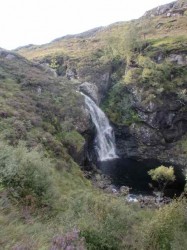 Route planning is crucial, as the terrain is sprinkled with lochans connected by large streams and obviously no bridges. We saw no-one, and left Man Friday footprints across the beach of Loch Mhadaidh, then picked up a stream to follow for another 5k, up its featureless valley, steadily gaining height and noticing more and more the pressure of the incessant wind. Eventually, we arrived at a stalkers path which took us over a bealach to the southwest, and down to the Fionn Loch.
Route planning is crucial, as the terrain is sprinkled with lochans connected by large streams and obviously no bridges. We saw no-one, and left Man Friday footprints across the beach of Loch Mhadaidh, then picked up a stream to follow for another 5k, up its featureless valley, steadily gaining height and noticing more and more the pressure of the incessant wind. Eventually, we arrived at a stalkers path which took us over a bealach to the southwest, and down to the Fionn Loch.
East of Fionn, brood Britains most remote mountains of Ruadh Stac Mhor and A'Mhaighden. At their feet, huddles the shooting lodge of Carnmore ....... access for the shooters chiefly involves two boat journeys linked by a pony ride.
The wind was incessant, pushing and pulling at everything, getting colder in the late afternoon. We opted for the rough shelter -- NOT a bothy, just an old cowshed which is left open for shelter.
The metal roof is held on by two tensioned lorry straps......the probing, poking wind kept finding these in turn
Twangbangflapflaprattlesmackchatterchatter.........
Like being inside a huge guitar........ Twangbangflapflaprattlesmackchatterchatter......... Then 4 Germans arrived, looking exhausted and we made some conversation Twangbangflapflaprattlesmackchatterchatter.........
They has taken 2 days to get from Kinlochewe ,Twangbangflapflaprattlesmackchatterchatter.........
Franz asked how much our sacs weighed Twangbangflapflaprattlesmackchatterchatter.........
and he was astonished at our 10kg, as he was carrying 20kg which explained the slow progress !!. Some nice fresh food, jah, but lightweight they were not. Twangbangflapflaprattlesmackchatterchatter.........
The evening passed with various ineffectual attempts to lodge timber pieces beneath the ungovernable roof straps. With the wind forecast even higher the following day, we decided against a climb to 600 metres through the narrow pass and higher level route by Lochan Fada. Instead, we'd cross the causeway where Fionn Loch joins Dubh Loch, and over the bealach to Letterewe Lodge.
The wind was whipping great spouts of water along the Dubh Loch next morning. Fortunately the causeway wasn't too narrow, and crossing in between the waterspouts, the risk of being blown off wasn't too bad after all !
With some final glances at the immense cirque of rock buttresses all around us, we crossed the next bealach on a track down to Letterewe, isolated on the north side of Loch Maree.
From here, a steady tramp rising and falling alongside Loch Maree, always into the wind wind wind, with eventually the bulk of Slioch rising hugely above us. The remembered path from Slioch some further miles brought us almost to the car park, at Incheril, and a little closer to habitation than we'd planned, but then we swung away northeast up a track to the Heights of Kinlochewe. Where a small river had carved itself into the valley floor, we found a cosy hidden bit of strath, large enough for a tent and a fire, and tucked out of the way of the still non-stop wind.
On our third morning, the wind was calming down as we went steadily uphill alongside the stream in Strath Chrombuill. Not a name you will find in the mountaineering books.......its a lonely valley on the far side of Fionn Bheinn, and few people have cause to go there. However it links through to the south side of Loch Fannaich....... and if you've done all the Fannaichs from the north side, its great to see the panorama of summits from this new angle.
A lunch stop was feasible once the wind had become merely a fresh breeze. Finally a track south across the moorlands, passing an old iron sign for Cadbhuidhe Lodge - long since drowned below the Loch - and we dropped down to the A832, and the comforts of the well-known Ledgowan.
A grand through trip. I'd done the "Big Six" from the north;- but the stay at Carnmore beneath the awesome cliffs will be an abiding memory
ANDREW




